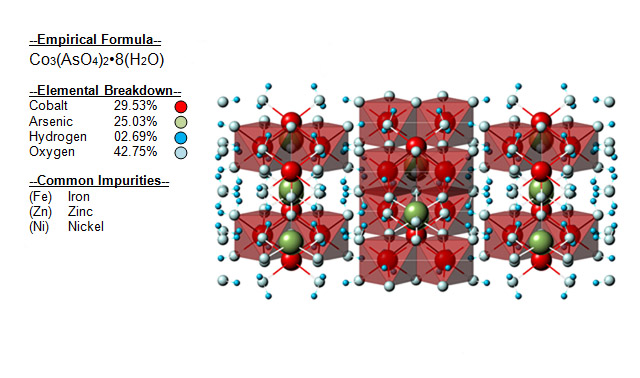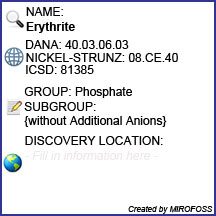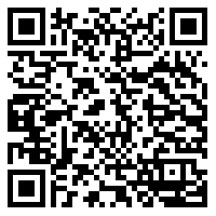

| Mineral Name | Erythrite |
| First Discovered | 1832 |
| Nickel-Strunz Classification | 08.CE.40 |
| Dana Classification | 40.03.06.03 |
| ICSD | 81385 |
| Mineral Group | Phosphates |


| Cleavage | Perfect |
| Colour(s) | Colourless, Violet red, Light pink, Purple red |
| Specific Gravity | 3.12 |
| Diaphaneity | Transparent to Sub transparent |
| Fracture | Sectile - Curved shavings or scrapings produced by a knife blade |
| Mohs Hardness | 1.5 to 2.0 |
| Luminescence | Non-fluorescent |
| Lustre | Pearly |
| Streak | Pinkish red |
| Habit(s) | Divergent to Prismatic to Striated |
| Radioactivity | Non-radioactive |
| Magnetism | Non-magnetic |

The following health hazards should be noted when handling erythrite:
 |
ENVIRONMENTAL HAZARD erythrite contains the elements Arsenic and Cobalt which are known to cause long term environmental effects. |
 |
TOXIC Conichalcite contains the element Arsenic which is fatal if ingested. |

The following image shows the Elemental breakdown of the mineral erythrite along with the mineral crystal structure.


| Crystal System | Monoclinic |  |
| Class | Prismatic | |
| Axial Ratios | a : b : c = 0.7629 : 1 : 0.3545 | |
| Morphology | Crystals prismatic to acicular and typically flattened; deeply striated or furrowed. Crystals are rare; frequently as radial or stellate groups; globular or reniform shapes with druzy surfaces and columnar or coarse-fibrous structure. Earthy or pulverulent. | |
| Optical Data Type | Biaxial(+) | |
| Pleochroism | Visible | |
| RL Values | nα = 1.626 - 1.629 nβ = 1.662 - 1.663 nγ = 1.699 - 1.701 | |
| 2V | Measured: 85° to 90°, Calculated: 88° to 90° | |
| Max Birefringence | δ = 0.073 (See colour chart at right) |  |
| Surface Relief | Moderate | |
| Comments | May be biaxial negative | |

Erythrite can be referenced in certain current and historical texts under the following nine names:
The mineral erythrite can be translated into the following select languages:
| Arabic | Bulgarian | Chinese (Sim) | 钴华 | ||
| Croatian | Czech | Danish | |||
| Dutch | Erythriet | Esperanto | Estonian | erütriit | |
| Finnish | erytriitti | French | érythrite | German | Erythrin |
| Greek | Hebrew | Hungarian | Eritrin | ||
| Italian | Eritrite | Japanese | エリトリット | Korean | 요르맆라읻 |
| Latin | Cobalti minera colore rubro | Lithuanian | Norwegian | ||
| Persian | اریتریت | Polish | Erytryn | Portuguese | eritrite |
| Romanian | Vanadinit | Russian | Эритрин | Slovak | |
| Spanish | Eritrina | Swedish | Koboltbeslag | Tagalog | |
| Turkish | eritrit | Ukrainian | Еритрин | Vietnamese |

Erythrite can be found in a few places around the world. The map below shows major documented concentrations of erythrite:


 |
The MIROFOSS database offers free printable geological identification tags for personal and non-profit use. These tags can be used to properly identify mineral samples in your collection. -Click here- to download a full size jpeg image for a erythrite identification tag; which can be printed on paper or used with a plastic laser printer. |
 |
What's this? What can I do with it? |

| Crystallography | Larsen, E.S. and Berman, H. (1934) The Microscopic Determination of the Nonopaque Minerals, Second edition, USGS Bulletin 848: 120, 178. |
| Crystallography | G. H. Faye and E. H. Nickel (1968): The origin of pleochroism in erythrite. Can. Mineral. 9, 493-504. |
| History | Anthony, J.W., Bideaux, R.A., Bladh, K.W., and Nichols, M.C. (2000) Handbook of Mineralogy, Volume IV. Arsenates, Phosphates, Vanadates. Mineral Data Publishing, Tucson, AZ, 680 pp.: 159. |
| History | Wolfe (1940) American Mineralogist: 25: 804. |
| Geograpcial Data | Mindat.org. Retrieved on 2012-05-30 |
| Physical Identification | Webmineral.com. Retrieved on 2012-05-30 |
| May 30, 2012 | The last time this page was updated |
| ©2017 MIROFOSS™ Foundation | |
 |